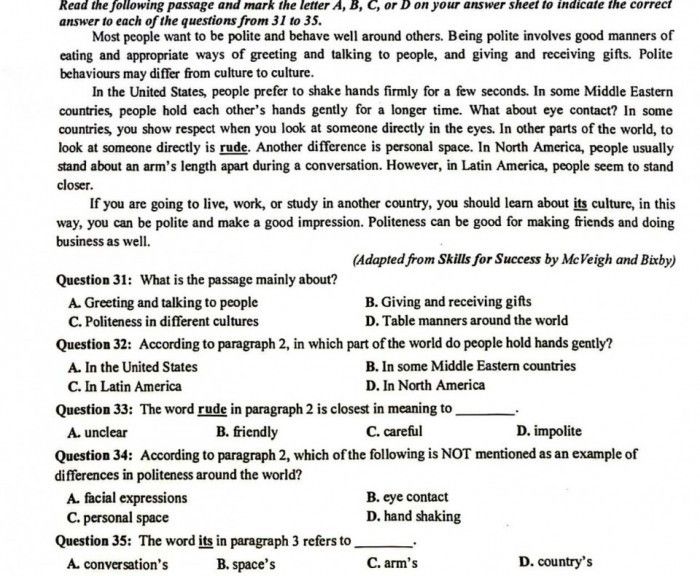Question 31: What is the passage mainly about? A. Greeting and talking to people B. Giving and receiving gifts C. Politeness in different cultures D. Table manners around the world
Answer: C. Politeness in different cultures
The passage discusses various aspects of politeness in different cultures, such as greeting, eye contact, and personal space.
Question 32: According to paragraph 2, in which part of the world do people hold hands gently? A. In the United States B. In some Middle Eastern countries C. In Latin America D. In North America
Answer: B. In some Middle Eastern countries
The passage states that in some Middle Eastern countries, people hold each other's hands gently for a longer time.
Question 33: The word rude in paragraph 2 is closest in meaning to A. unclear B. friendly C. careful D. impolite
Answer: D. impolite
The word "rude" is closest in meaning to "impolite."
Question 34: According to paragraph 2, which of the following is NOT mentioned as an example of differences in politeness around the world? A. facial expressions B. eye contact C. personal space D. hand shaking
Answer: A. facial expressions
The passage mentions hand shaking, eye contact, and personal space but does not mention facial expressions.
Question 35: The word its in paragraph 3 refers to A. conversation's B. space's C. arm's D. country's
Answer: D. country's
The word "its" in paragraph 3 refers to "country's," as it discusses learning about a country's culture.
4o
Trang chủ
Giải bài tập Online
Đấu trường tri thức
Dịch thuật
Flashcard - Học & Chơi
Cộng đồng
Trắc nghiệm tri thức
Khảo sát ý kiến
Hỏi đáp tổng hợp
Đố vui
Đuổi hình bắt chữ
Quà tặng và trang trí
Truyện
Thơ văn danh ngôn
Xem lịch
Ca dao tục ngữ
Xem ảnh
Bản tin hướng nghiệp
Chia sẻ hàng ngày
Bảng xếp hạng
Bảng Huy hiệu
LIVE trực tuyến
Đề thi, kiểm tra, tài liệu học tập








 Trả lời nhanh trong
Trả lời nhanh trong 



 Xem thêm
Xem thêm  Thưởng th.11.2024
Thưởng th.11.2024 Bảng xếp hạng
Bảng xếp hạng